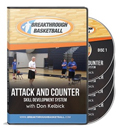How To Develop A Team Full Of Stephen Curry's - Skilled Shooters & Ball Handlers
2 on 2, 3 on 3, 4 on 4, 5 on 5, and disadvantage drills are an important part of our team practices. Each one has a purpose and can be tweaked to improve different aspects of game performance.
However, when it comes to improving individual ball skills, there is nothing better than structured 1 on 1 drills.
You don't have anybody to bail you out.
Against a good player, your weaknesses are exposed in ball handling, shooting, footwork, and finishing.
There is nowhere to hide. You have to get better.
1 on 1 games also fix two big issues for skill development workouts.
- You don't have enough players to do anything besides 1 on 1.
- You have enough players but varying skill levels leads to poor games of 2-on-2, 3-on-3, etc.
Use These 6 Tips To Improve Your Game Play With 1 on 1
But simply playing 1 on 1 can also lead to terrible habits such as over-dribbling, dribbling with your head down, bad shots, long possessions, etc.
You need to tweak your 1 on 1 drills so that they are game-like.
Here are 6 tips that you can use to improve your 1 on 1 drills.
- Use dribble limits - There isn't a better way to make players be more effective with your dribble than using dribble limits. You can limit particular drills to 2-to-3 dribbles. You can even do some post drills with no dribble to improve footwork.
- Use shot clock of 5 to 10 seconds - This will ensure there isn't dancing or dribbling around. You have to go! Just like you would during a game.
- Play mini-games - To keep games intense. Play short games. If you go by 1's, play to 3. If you go by 2's and 3's, play to 9. Then go onto the next drill.
- 1 shot and done - To ensure that the player takes a quality shot, only allow one shot. You can always tweak this if you want to work on blocking out.
- Adjust the playing area available - A couple of simple ways to do this is to confine the space or make the space wider. Depending on your objective, both can be very effective.
For confining the space, you can use cones to create a narrow lane. The more you confine the space, the more challenging it is for the offense. It also makes it more game-like as you have to be efficient with your dribble and move in straight lines.
If you want to make it more challenging for the defense, you could use the entire court. If you can defend an offensive player over the entire court, this makes defense much easier when you have 4 other defenders on the court. It is also a great tool to improve athleticism and conditioning. - Mimic game-like situations - Use situations that happen most often during games. You could probably come up with 1,000 effective 1 on 1 drills just by being a little creative.
To save yourself time, you can always take a look at our 30 Competitive Skill Development Drills. 23 of the drills are specifically 1 on 1 drills.
It will probably also spur some ideas of different drills that you can do.
Recommended DVD's & eBook:

|
The Attack & Counter Skill Development System This eBook & DVD's will improve your shooting, ballhandling, footwork, perimeter moves, post moves, finishing, aggressiveness, quickness, confidence, mentality, and your all-around game! Designed by NBA skills coach Don Kelbick, this unique and comprehensive system is incredibly simple when compared to other skill development programs. Yet it works with NBA and pro players at the highest level... (more info) |
Do you have any ideas or tips for 1 on 1 drills?
|
||||||||||||||||||||



 Facebook (145k Followers)
Facebook (145k Followers) YouTube (152k Subscribers)
YouTube (152k Subscribers) Twitter (33k Followers)
Twitter (33k Followers) Q&A Forum
Q&A Forum Podcasts
Podcasts